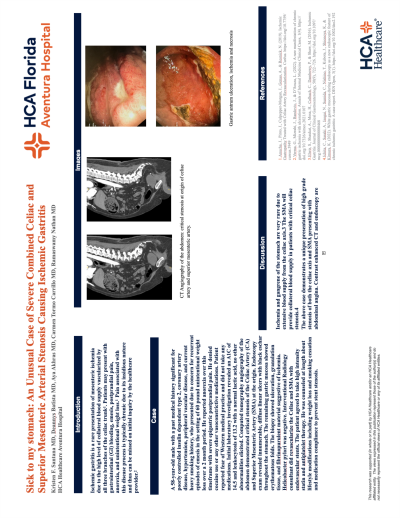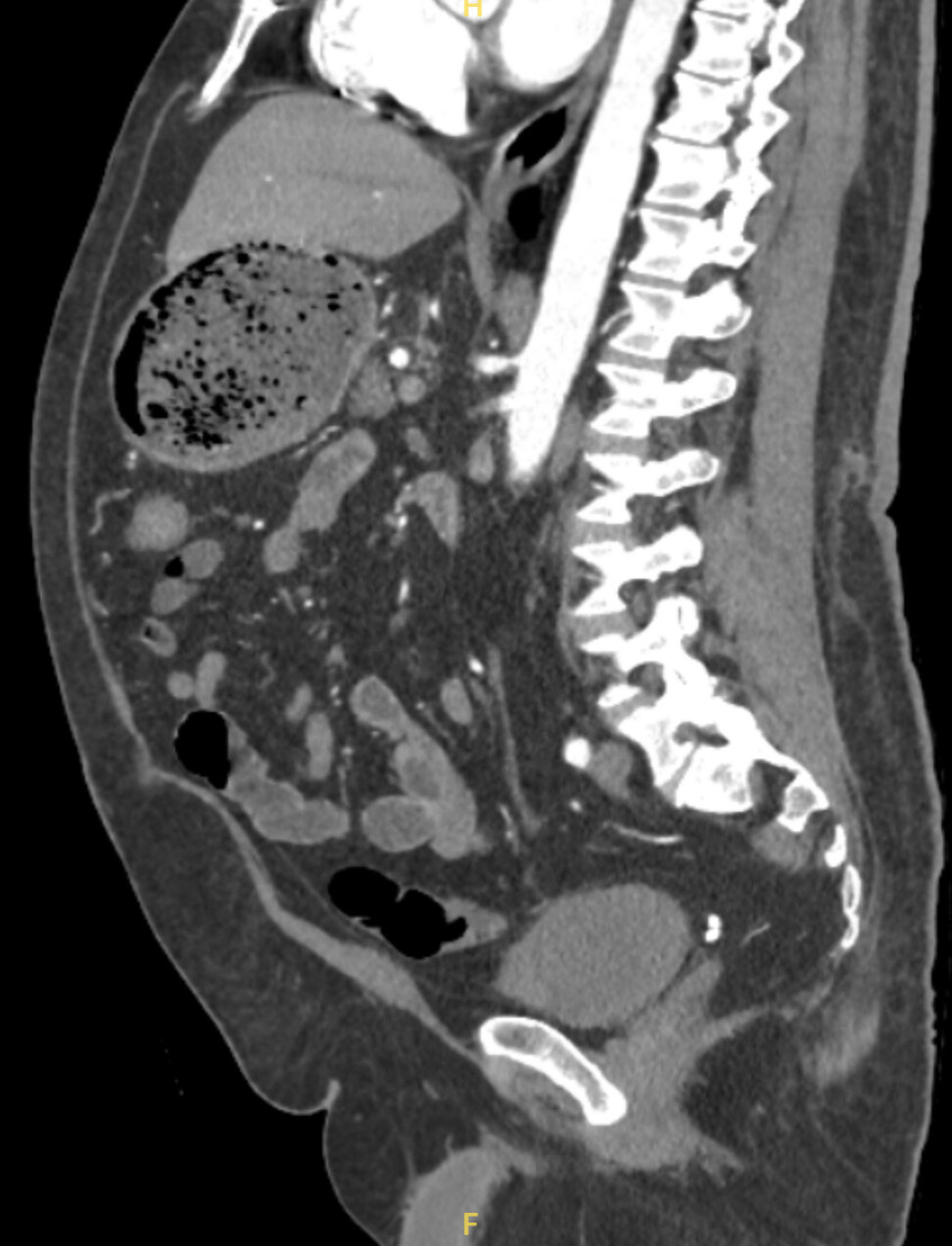Monday Poster Session
Category: Stomach
P3368 - Sick to my stomach: An Unusual Case of Severe Combined Celiac and Superior Mesenteric Arterial Stenosis Causing Ischemic Gastritis
Monday, October 28, 2024
10:30 AM - 4:00 PM ET
Location: Exhibit Hall E

Has Audio

Kristen Santana, MD
Aventura Hospital
Aventura, FL
Presenting Author(s)
Kristen Santana, MD1, Deannys Batista, MD2, Aya Akhras, MD1, Carmen Tormo, MD3, Ramasamy Nathan, MD1
1Aventura Hospital, Aventura, FL; 2Aventura Hospital, Miami, FL; 3HCA Florida Aventura Hospital, Aventura, FL
Introduction: Ischemic gastritis is a rare presentation of mesenteric ischemia due to the high level of collateral blood supply vascularized by all three branches of the celiac trunk1. Patients may present with gastrointestinal (GI) bleeding, emesis, postprandial pain, anorexia, and unintentional weight loss.1 Pain associated with this disease process is typically chronic due to its insidious nature and thus can be missed on initial inquiry by the healthcare provider.2
Case Description/Methods: A 58-year-old male with a past medical history significant for poorly controlled insulin dependent type 2, coronary artery disease, hypertension, peripheral vascular disease, and current heavy smoking history, who presented due to concern for recurrent episodes of emesis in the setting of 60 pound unintentional weight loss over a 2 month period. He reported anorexia over this timeframe with severe epigastric postprandial pain. He denied cocaine use or any other vasoconstrictive medications. Patient reported fear of Western medical practice and did not take any medications. Initial laboratory investigation revealed an A1C of 14.5 and leukocytosis of 13.2 with a normal lactic acid, no other abnormalities elicited. Computed tomography angiography of the abdomen demonstrated critical stenosis of the Celiac Artery (CA) and Superior Mesenteric Artery (SMA) at the origin. Endoscopy exam revealed innumerable, diffuse linear ulcers with black eschar throughout the stomach. The remaining gastric mucosa showed erythematous folds. The biopsy showed ulceration, granulation tissue, and fibrinopurulent material suggestive of ischemia. Helicobacter pylori was negative. Interventional Radiology consultant did revascularize the Celiac and SMA with endovascular stents. The patient agreed to take high intensity statin and antiplatelet therapy. He was counseled at length about lifestyle modifications including weight loss and smoking cessation and medication compliance to prevent stent stenosis.
Discussion: Ischemia and gangrene of the stomach are very rare due to extensive blood supply from the celiac axis.3 The SMA will provide collateral blood supply in patients with critical celiac stenosis.4
The above case demonstrates a unique presentation of high grade stenosis of both the celiac axis and SMA presenting with abdominal angina. Contrast enhanced CT and endoscopy are essential to establish the diagnosis.3

Disclosures:
Kristen Santana, MD1, Deannys Batista, MD2, Aya Akhras, MD1, Carmen Tormo, MD3, Ramasamy Nathan, MD1. P3368 - Sick to my stomach: An Unusual Case of Severe Combined Celiac and Superior Mesenteric Arterial Stenosis Causing Ischemic Gastritis, ACG 2024 Annual Scientific Meeting Abstracts. Philadelphia, PA: American College of Gastroenterology.
1Aventura Hospital, Aventura, FL; 2Aventura Hospital, Miami, FL; 3HCA Florida Aventura Hospital, Aventura, FL
Introduction: Ischemic gastritis is a rare presentation of mesenteric ischemia due to the high level of collateral blood supply vascularized by all three branches of the celiac trunk1. Patients may present with gastrointestinal (GI) bleeding, emesis, postprandial pain, anorexia, and unintentional weight loss.1 Pain associated with this disease process is typically chronic due to its insidious nature and thus can be missed on initial inquiry by the healthcare provider.2
Case Description/Methods: A 58-year-old male with a past medical history significant for poorly controlled insulin dependent type 2, coronary artery disease, hypertension, peripheral vascular disease, and current heavy smoking history, who presented due to concern for recurrent episodes of emesis in the setting of 60 pound unintentional weight loss over a 2 month period. He reported anorexia over this timeframe with severe epigastric postprandial pain. He denied cocaine use or any other vasoconstrictive medications. Patient reported fear of Western medical practice and did not take any medications. Initial laboratory investigation revealed an A1C of 14.5 and leukocytosis of 13.2 with a normal lactic acid, no other abnormalities elicited. Computed tomography angiography of the abdomen demonstrated critical stenosis of the Celiac Artery (CA) and Superior Mesenteric Artery (SMA) at the origin. Endoscopy exam revealed innumerable, diffuse linear ulcers with black eschar throughout the stomach. The remaining gastric mucosa showed erythematous folds. The biopsy showed ulceration, granulation tissue, and fibrinopurulent material suggestive of ischemia. Helicobacter pylori was negative. Interventional Radiology consultant did revascularize the Celiac and SMA with endovascular stents. The patient agreed to take high intensity statin and antiplatelet therapy. He was counseled at length about lifestyle modifications including weight loss and smoking cessation and medication compliance to prevent stent stenosis.
Discussion: Ischemia and gangrene of the stomach are very rare due to extensive blood supply from the celiac axis.3 The SMA will provide collateral blood supply in patients with critical celiac stenosis.4
The above case demonstrates a unique presentation of high grade stenosis of both the celiac axis and SMA presenting with abdominal angina. Contrast enhanced CT and endoscopy are essential to establish the diagnosis.3

Figure: Celiac Artery and Superior Mesenteric Artery Severe Stenosis at the origin points.
Disclosures:
Kristen Santana indicated no relevant financial relationships.
Deannys Batista indicated no relevant financial relationships.
Aya Akhras indicated no relevant financial relationships.
Carmen Tormo indicated no relevant financial relationships.
Ramasamy Nathan indicated no relevant financial relationships.
Kristen Santana, MD1, Deannys Batista, MD2, Aya Akhras, MD1, Carmen Tormo, MD3, Ramasamy Nathan, MD1. P3368 - Sick to my stomach: An Unusual Case of Severe Combined Celiac and Superior Mesenteric Arterial Stenosis Causing Ischemic Gastritis, ACG 2024 Annual Scientific Meeting Abstracts. Philadelphia, PA: American College of Gastroenterology.
